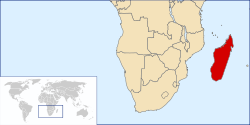Democratic Republic of Madagascar
| Democratic Republic of Madagascar | ||||||||||
|
Repoblika Demokratika Malagasy République démocratique de Madagascar |
||||||||||
|
||||||||||
|
||||||||||
|
Motto Tanindrazana, Tolom-piavotana, Fahafahana "Fatherland, Revolution, Freedom" • Mpiasa eran'izao tontolo izao, mampiray! "Workers of the world, unite!" |
||||||||||
|
Anthem Ry Tanindrazanay malala ô! "Oh, beloved land of our ancestors!" |
||||||||||
|
Location of the Democratic Republic of Madagascar in Africa
|
||||||||||
| Capital | Antananarivo | |||||||||
| Languages | Malagasy · French | |||||||||
| Government | Unitary One-party socialist state | |||||||||
| President | ||||||||||
| • | 1975–1992 | Didier Ratsiraka | ||||||||
| Prime Minister | ||||||||||
| • | 1976 | Joel Rakotomalala | ||||||||
| • | 1991–1992 | Guy Razanamasy | ||||||||
| Legislature | Popular National Assembly | |||||||||
| Historical era | Cold War | |||||||||
| • | Established | December 30, 1975 | ||||||||
| • | Constitution adopted | September 12, 1992 | ||||||||
| Area | ||||||||||
| • | 1975 | 587,040 km² (226,657 sq mi) | ||||||||
| Population | ||||||||||
| • | 1975 est. | 7,568,577 | ||||||||
| Density | 12.9 /km² (33.4 /sq mi) | |||||||||
| • | 1992 est. | 12,596,263 | ||||||||
| Density | 21.5 /km² (55.6 /sq mi) | |||||||||
| Currency | Malagasy franc (ariary) | |||||||||
|
||||||||||
| Today part of |
|
|||||||||
The Democratic Republic of Madagascar (Malagasy: Repoblika Demokratika Malagasy, French: République démocratique de Madagascar) was a socialist state that existed on the island of Madagascar from 1975 until 1992.
Didier Ratsiraka was elected to a seven-year term as president in a national referendum on December 21, 1975, confirming the mandate for consensus and inaugurating Madagascar's Second Republic. The guiding principle of Ratsiraka's administration was the need for a socialist "revolution from above." Specifically, he sought to radically change Malagasy society in accordance with programs and principles incorporated into the Charter of the Malagasy Socialist Revolution, popularly referred to as the "Red Book" (Boky Mena). According to this document, the primary goal of the newly renamed Democratic Republic of Madagascar was to build a "new society" founded on socialist principles and guided by the actions of the "five pillars of the revolution": the Supreme Revolutionary Council (SRC), peasants and workers, young intellectuals, women, and the Popular Armed Forces. "The socialist revolution," explains the Red Book, "is the only choice possible for us in order to achieve rapid economic and cultural development in an autonomous, humane, and harmonious manner." The Red Book advocated a new foreign policy based on the principle of nonalignment, and domestic policies focused on renovating the fokonolona, decentralizing the administration, and fomenting economic development through rigorous planning and popular input.
Several early policies collectively decided by Ratsiraka and other members of the SRC set the tone of the revolution from above. The first major SRC decision was to bring the French-held sectors of the economy under government control. This "economic decolonization" was welcomed by nationalists, who long had clamored for economic and cultural independence from France. The government also lifted martial law but retained rigid press censorship. Finally, the SRC ordered the closure of an earth satellite tracking station operated by the United States as part of its commitment to nonaligned foreign relations.
...
Wikipedia



